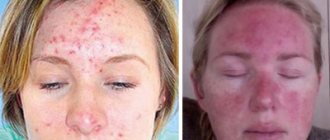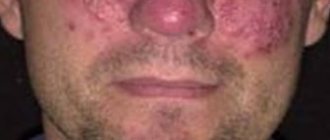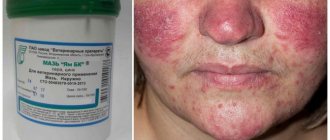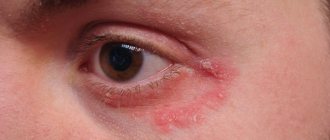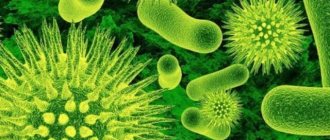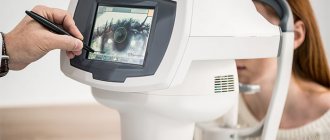Author
Kulova Zhanna Borisovna
Head of the Center for Cosmetology and Preventive Medicine
Cosmetologist
until January 31
We are giving away 1000 rubles for all services for a visit in January More details All promotions
Demodex analysis
allows you to identify subcutaneous mites from the genus Demodex, which causes one of the types of dermatosis (demodex).
demodex mite
The demodex mite (or glandular acne) has a very small size (from 0.2 to 0.5 mm), settles mainly in the sebaceous glands and hair follicles, and cannot be detected with the naked eye.
Demodex is considered an opportunistic microorganism, meaning it can be found on the skin of a healthy person. But under certain conditions (decreased immunity, metabolic disorders, endocrine diseases, diseases of the gastrointestinal tract), the mite becomes more active, which leads to the development of demodicosis.
Detailed description of the study
The problem of skin diseases caused by parasites is associated with their widespread distribution. Demodicosis is one of these diseases, its frequency is about 2-5% among the world's population. It is in eighth place among skin diseases in terms of occurrence. In addition, by affecting the skin of the face, demodicosis can lead to social maladjustment of patients and a decrease in their quality of life.
Demodicosis is a disease caused by mites of the genus Demodex. There are about 70 species of this genus, but only two are associated with this disease: Demodex folliculorum (longus), found in the follicular infundibulum, and Demodex brevis, found in the sebaceous and meibomian glands. The first of these, Demodex folliculorum, lives in hair follicles, while Demodex brevis lives in the sebaceous glands associated with hair follicles. Both are found primarily on the face, near the nose, eyelashes and eyebrows, but they are also found in other places on the body.
The viability of the tick remains outside the human body if factors such as constant humidity, darkness, and room temperature are observed. In such conditions, he can live for more than 8 days. The optimal temperature for tick life is considered to be 30-40°C; when it drops to 14°C, it goes into suspended animation, and at 52°C it dies. In an aquatic environment, it remains viable for up to 20-25 days. Favorable habitats for ticks are: vegetable oil, petroleum jelly or fat.
The Demodex mite is believed to be an opportunistic organism and lives on the skin of approximately 90% of people. In a normal state of immunity, these mites do not leave the boundaries of the surface layer of the skin, or rather the basement membrane. Mites live in hair follicles, feeding on secretions produced during normal skin function. If the normal functioning of the skin is disrupted in the form of changes in the secretion of the sebaceous glands, an increase in the amount of sebum; disruption of the endocrine, immune and nervous systems, as well as with prolonged external use of corticosteroids, the protective reaction of the skin changes. This promotes the reproduction of representatives of the genus Demodex.
The disease occurs everywhere. The greatest activity of Demodex mites is observed in the spring and summer. This is due to an increase in ambient temperature. The prevalence of ticks depends on age. Thus, in the age group up to 20 years, demodicosis is detected in 20% of people who applied for frequent symptoms of this disease, in the period from 30 to 45 years - in 43%, and by 70 years of age - in 95-100%.
Clinical manifestations of demodicosis may include the following changes on the skin:
- Asymmetrical red spots;
- Spider veins;
- The appearance of areas of dryness and flaking of the skin;
- Lesions or diffusely altered skin thickening;
- Nodular formations are pink or red.
Often the symptoms of demodicosis are similar to the clinical picture that occurs with various skin diseases (acne vulgaris, rosacea, perioral dermatitis).
Mites can also cause damage to the eyelids, cornea and conjunctiva of the eyes (blepharokeratitis, blepharoconjunctivitis). When the eyes are affected, hyperkeratosis is noted with the presence of scales and a “collar” around the eyelashes, dysfunction of the meiboic and sebaceous glands. Patients complain of itching, a sensation of a foreign body in the eyes, swelling, burning and hyperemia of the edges of the eyelids and conjunctiva. The disease often remains unrecognized in time due to similar symptoms to a number of other skin and eye pathologies. Examination of eyelashes and skin scrapings helps determine the presence of these mites.
When is a demodex test prescribed?
Demodex analysis is prescribed for chronic dermatosis with the following symptoms:
- itching of the skin of the face and eyelids, intensifying in the evening;
- redness and inflammation of the skin; the skin becomes lumpy, nodules (papules) appear, resembling acne;
- When the eyelids are affected, the edges of the eyelids may become inflamed, mucus may be released, and white scales may appear on the eyelashes.
The demodex mite feeds on the contents of the sebaceous glands, so the skin is most often affected in those places where the sebaceous glands are most numerous - the wings of the nose, the nasolabial triangle, and the chin.
Analysis for demodex makes it possible to diagnose demodicosis, that is, to establish that the cause of dermatosis in this case is the demodex mite, and to prescribe the correct treatment.
References
- Fromstein, S., Harthan, J., Patel, J. et al. Demodex blepharitis: clinical perspectives. Clin Optom (Auckl), 2022. - Vol. 10. - P. 57-63.
- Jacob, S., VanDaele, M., Brown, J. Treatment of Demodex-associated inflammatory skin conditions: A systematic review. Dermatol Ther., 2022. - Vol. 32(6).
- Bitton, E., Aumond, S. Demodex and eye disease: a review. Clin Exp Optom., 2022.
- Elistratova, L.L., Potaturkina-Nesterova, N.I., Nesterov, A.S. Current state of the problem of demodicosis. Fundamental Research, 2011. - No. 9-1. — P. 67-69.
How is demodex analysis performed?
The biological material for analysis for demodex is skin scraping. If the eyelids are affected, eyelashes are taken for analysis (4-6 eyelashes from each eyelid).
Biological material is placed in a special solution and examined under a microscope (microscopic examination is performed).
Biological material is collected for analysis by a dermatologist. The research is carried out in the laboratory. If necessary, demodex analysis can be performed in CITO mode (i.e. urgently).
Preventive measures to prevent demodicosis
During primary infection with this disease, prevention should be aimed at a general increase in immunity.
Maintaining hygiene, alternating visual stress with periods of rest, and regular visits to an ophthalmologist for preventive examinations are of great importance.
If the disease is chronic, prevention should be focused on eliminating self-infection:
- To wipe your eyes, you must use disposable wipes.
- Treat glasses with antiseptic solutions.
- Minimize contact with your face and avoid touching your eyes unnecessarily.
- Treat your face with lotions containing alcohol.
- Disinfect razors.
- After massaging the eyelids, wash your face.
- Change bed linen as often as possible, or before going to bed, place a disposable cloth napkin on the pillow, or iron the linen with a hot iron.
All cosmetics, tools for applying them, and lenses must be disinfected or disposed of. If these rules are followed, the cured pathology will not arise again and will not spread to other areas of the skin.
Symptoms of demodicosis
Clinical manifestations occur after the eye mite penetrates the hair follicle area. As their number grows, the following symptoms become more pronounced:
- inflamed eyelash follicles;
- red rashes of a dermatological nature;
- excessive eyelash loss;
- swelling, purulent discharge, burning, sensation of a foreign object in the eyes;
- itching, pain, peeling, small ulcers.
In difficult situations, acne appears on the patient's face. In some cases, a runny nose develops, not accompanied by other symptoms characteristic of a cold.
The pathology can occur in isolation or be combined with blepharitis, conjunctivitis, keratitis, demodectic seals on the face and other parts of the body.
Why does demodicosis occur in some people and not in others?
Almost every person has a subcutaneous mite. However, not everyone develops the disease. The active reproduction of ticks is caused by a decrease in immunity caused by one reason or another. For example, chronic diseases of the gastrointestinal tract, endocrine system, liver and pancreas, poor diet or sedentary lifestyle can cause a decrease in the body's protective abilities and, as a result, the development of such an ailment as demodicosis on the face. Many patients have noticed that as soon as they break their diet for demodicosis and include a large amount of sweet and starchy foods in their diet, their skin instantly “reacts.”
Treatment
Treatment of demodicosis is not aimed at completely getting rid of the mite, since its presence is considered normal. Therapy involves measures to reduce the activity of microorganisms and reduce their number in a certain area of the skin.
Traditionally, treatment begins with procedures to relieve exacerbation. At the same time, the specialist identifies the reasons that led to the activation of the tick. Achieving long-term remission is considered a success.
In clinic No. 2 named after. Semashko has the necessary resources to conduct research on samples of materials for the presence of demodex mites. Experienced dermatologists, trichologists and ophthalmologists have effective therapeutic techniques in their arsenal that allow them to achieve high results.
Preparing for demodex analysis
In order to correctly take a demodex test, minimal preparation is required: you should not wash your face for 24 hours before the test. You should also not use cosmetics (it is better to stop using cosmetics a few days before the test).
It is advisable to take the test after 18-00, since the tick avoids sunlight, and during the daytime its activity is minimal.
Sign up for diagnostics Do not self-medicate. Contact our specialists who will correctly diagnose and prescribe treatment.
How to get rid of demodicosis of the eyelids in humans
If the patient has skin rashes combined with severe itching and redness, you should contact specialized specialists:
- If the parasite is localized on the eyelids and the eyelash bulbs are damaged, an ophthalmologist is involved in the restoration.
- For foci of inflammation on the scalp - a trichologist.
- If the skin is affected, you should consult a dermatologist.
Treatment for demodicosis usually takes place without any problems, but recovery can take up to 6 months. The beginning of therapy consists of stopping the infection channel and normalizing the protective functions of the epidermis.
Recovery must be comprehensive. To do this, the doctor collects a detailed medical history. Based on the information received, he prescribes the appropriate treatment option. Usually it consists of:
- taking immunomodulators, vitamin complexes;
- prescribing medications to restore the functioning of the gastrointestinal tract;
- use of broad-spectrum anthelmintic drugs;
- prescribing antihistamines to reduce irritation;
- constant treatment of problem areas with medicinal compounds and ointments.
Ointments and gels prescribed by doctors reduce the number of adult individuals and prevent their subsequent reproduction, eliminating the increase in localization areas. Demodex-complex , consisting of soap, cream, and tonic, are prescribed as an addition to treatment
To increase the effectiveness of combating and preventing the disease, you can use Demazol medicinal shampoo. The plant components included in the composition - tansy, chamomile, verbena, string, birch tar - are effective for dermatitis of various etiologies. They contribute to the death of eye mites, parasite larvae and eggs. The product is protected by Russian patents: No. 2611347, No. 2611346, No. 2192860. RF patents in the name of I.B. Medvedev

